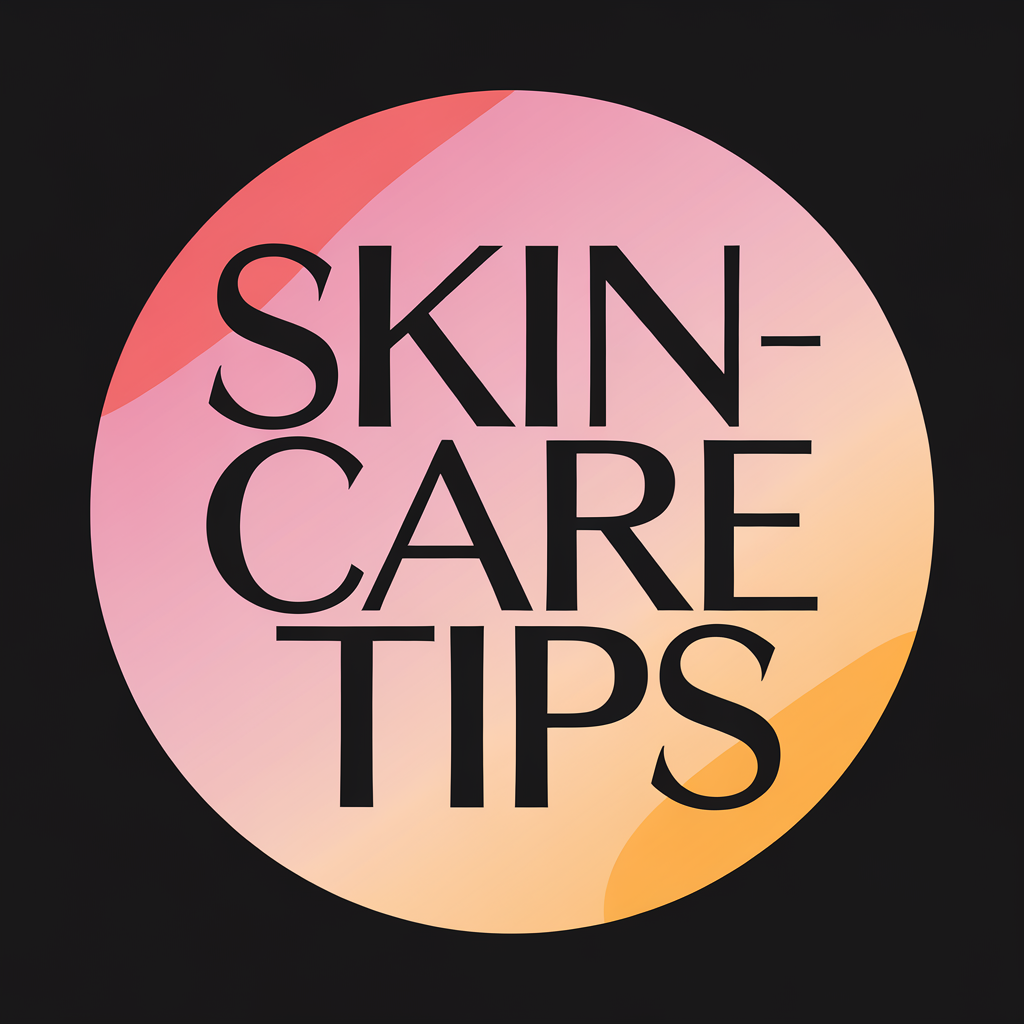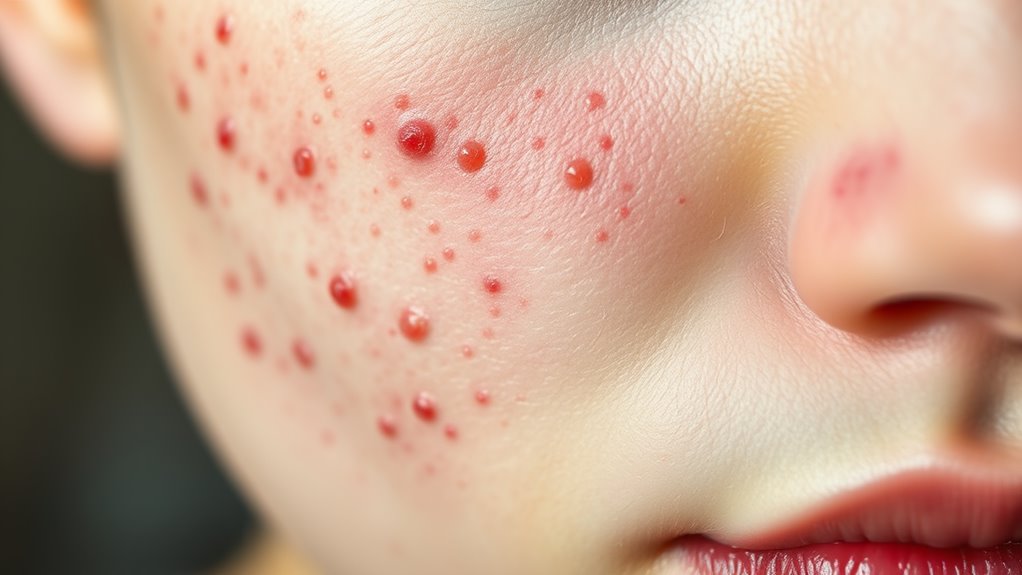Why You’re Breaking Out After Changing Products
You’ve just switched to a new retinoid serum, and now you’re noticing more breakouts than usual. This might be skin purging, where active ingredients accelerate cell turnover. Stick around to uncover the real causes and effective solutions.
Key Takeaways
- Changing products can trigger skin purging, where active ingredients accelerate cell turnover, causing temporary breakouts.
- New ingredients may cause allergic reactions, leading to inflammation and pimples.
- Harsh chemicals in new products can irritate the skin barrier, resulting in redness and breakouts.
- A pH imbalance from new formulations can disrupt the skin’s natural balance, promoting acne.
- Product buildup or clogged pores from altered routines can lead to unexpected breakouts.
What Is Skin Purging?
Have you ever switched skincare products and noticed a sudden breakout? This could be skin purging, not a true breakout.
Purging happens when active ingredients like retinoids speed up your skin’s cell turnover, pushing out clogged pores and revealing hidden impurities temporarily.
Unlike a breakout, which might signal an allergy or irritation, purging is a positive sign that your product works, typically lasting 4-6 weeks.
Experts note it’s common with exfoliants, so you don’t need to panic—it’s your skin’s natural process adapting.
Stay consistent for clearer results.
It’s important to distinguish skin purging from adverse reactions to ensure you’re not mistaking irritation for a normal adjustment.
Identifying Breakouts After Product Changes
Differentiating skin purging from a true breakout helps you manage your skincare effectively. When you change products, track your skin’s response closely, noting timing and patterns to spot potential purging. This ensures you don’t abandon beneficial ingredients prematurely. Understanding your skin type is crucial for selecting products that minimize future breakouts and promote healthier skin.
| Aspect | Key Indicator |
|---|---|
| Onset Timing | Occurs 1-4 weeks after change |
| Spot Appearance | Small, uniform bumps |
| Affected Areas | Where product is applied |
| Skin Sensation | Mild redness or dryness |
Differences Between Purging and Actual Breakouts
When you switch skincare products and notice breakouts, it’s essential to identify purging signs, such as temporary flare-ups from deep-cleansing ingredients, versus breakout indicators like persistent pimples or inflammation.
Purging typically resolves within a few weeks as your skin adjusts, while actual breakouts signal ongoing issues that require different interventions.
These key differences empower you to make informed decisions about your routine based on how your skin responds.
To better manage actual breakouts, consider investigating hidden acne triggers that could be underlying causes beyond product changes.
Purging Signs
Skin purging often mimics a real breakout, but you’ll spot the differences by noting how quickly blemishes appear and fade after switching products.
You’ll notice purging when blemishes emerge rapidly, within 1-4 days, and resolve in 4-6 weeks.
These are typically small pimples or whiteheads in your usual trouble spots.
Evidence-based research shows this is your skin’s way of expelling built-up debris from active ingredients.
Common signs include a sudden increase in acne that doesn’t spread to new areas.
This process is temporary and beneficial, as it clears out pores faster.
Dermatologists agree that purging is a sign your product is working, not failing.
Breakout Indicators
To distinguish purging from a genuine breakout, you’ll need to watch for key signs like duration and location.
Purging typically lasts 4-6 weeks as your skin expels built-up impurities from new products, whereas genuine breakouts persist longer, indicating a reaction.
For location, purging affects areas with existing congestion, like your T-zone, while genuine ones might spread to unexpected spots.
You’ll also notice purging breakouts mirror your usual acne types, such as small pimples, but genuine ones could escalate in severity.
Track these patterns diligently to evaluate your skin’s true response effectively.
Key Differences
Understanding the key differences between purging and actual breakouts helps you make informed decisions about your skincare routine.
Purging occurs when active ingredients, like retinoids, accelerate your skin’s natural cycle, revealing hidden blemishes that fade within 4-6 weeks.
You recognize it by uniform breakouts in treated areas.
Actual breakouts, however, stem from product irritation or allergies, appearing as random, persistent spots that worsen over time.
If breakouts spread or persist beyond a month, consult a dermatologist; this isn’t purging but a reaction needing adjustment.
Track changes to differentiate and adjust effectively.
Common Causes of Skin Reactions
When you switch skin care products, allergic triggers like certain fragrances or preservatives can spark an immune response that leads to breakouts.
You’re also at risk from irritant factors, such as harsh chemicals or overly abrasive ingredients, which directly damage your skin’s protective barrier.
Understanding these causes helps you identify and avoid potential reactions effectively.
Additionally, using evidence-based ingredients can help calm irritation and strengthen the skin barrier for long-term relief.
Allergic Triggers
Allergic triggers, like pollen or pet dander, often spark skin reactions that affect millions.
When you switch products, hidden allergens such as fragrances, preservatives, or metals in cosmetics can trigger your immune system to overreact, causing breakouts like hives or eczema.
Research from the American Academy of Dermatology shows that contact allergies impact about 20% of people, especially those with sensitive skin.
You recognize these by sudden itching, swelling, or rashes after use.
To manage this, read ingredient lists carefully and perform patch tests; early detection prevents worsening reactions.
Irritant Factors
Irritants like harsh chemicals or rough fabrics directly provoke skin reactions by stripping away your protective barrier, often causing immediate redness, dryness, or stinging.
This happens because new products can introduce stronger agents that overwhelm your skin’s defenses, leading to inflammation.
To avoid this, recognize common irritants:
-
Harsh surfactants in cleansers that strip natural oils, disrupting your skin’s pH balance.
-
Alcohol-based ingredients that dehydrate and inflame sensitive areas.
-
Abrasive physical exfoliants like walnut shells, which cause micro-tears.
-
Synthetic fragrances that trigger contact dermatitis on compromised skin.
Evidence shows switching products slowly minimizes these reactions.
Factors That Influence Skin Responses
Various factors, such as your skin type, product ingredients, and environmental conditions, can significantly influence how your skin reacts to changes in your routine. For example, if you’re sensitive, certain ingredients might trigger inflammation, while dry skin could react poorly to stripping agents. Research shows these elements interact uniquely; a study in the Journal of Investigative Dermatology highlights how environmental stressors amplify responses. Additionally, formulation science plays a key role in how ingredients are combined to enhance compatibility and effectiveness for different skin types.
| Factor | Description | Impact on Skin |
|---|---|---|
| Skin Type | Oily, dry, or sensitive variations | Alters barrier function |
| Product Ingredients | Active compounds like acids | Causes irritation or adaptation |
| Environmental Conditions | Humidity, pollution, or UV exposure | Exacerbates sensitivity |
| Hormonal Factors | Fluctuations from stress or cycles | Triggers inflammatory responses |
Understanding these helps you anticipate reactions.
How to Manage Breakouts Effectively
How can you effectively manage breakouts that arise from skin changes?
By adopting evidence-based routines, you’ll reduce inflammation and support healing without aggravating your skin.
-
Cleans your face gently: Use a mild, pH-balanced cleanser twice daily to remove debris and excess oil, preventing further clogging based on dermatological studies.
-
Moisturize consistently: Apply a non-comedogenic formula to maintain your skin’s barrier, as research shows hydration minimizes breakout severity.
-
Target active spots: Treat pimples with salicylic acid or benzoyl peroxide to unclog pores and kill bacteria, drawing from clinical evidence for faster resolution.
-
Monitor and rest: Track your skin’s response daily and allow 4-6 weeks for adjustment, as experts recommend to avoid prolonged irritation.
To further enhance your routine, incorporate essential ingredients proven to combat acne through their mechanisms of action and effectiveness.
Tips for Safely Switching Skincare Products
Switching skincare products can trigger breakouts if you’re not careful, so you’ll want to follow proven strategies to minimize risks and maintain healthy skin.
First, patch test new items on a small area for 24-48 hours to spot reactions, as dermatological studies confirm this reduces irritation.
Introduce changes gradually—one product at a time—to avoid overwhelming your skin’s barrier.
Monitor for signs like redness or dryness, and keep a journal of responses.
If issues persist, consult a dermatologist for personalized advice, backed by clinical evidence.
Always choose formulations suited to your skin type for optimal results.
To enhance your routine further, focus on common skincare mistakes to ensure long-term skin health and prevent potential issues.

